The History Of OPEL Astra

The Opel Astra is a small family car designed and manufactured by Opel, the European subsidiary of General Motors.
It is branded as an Opel in continental Europe, the Republic of Ireland, the Middle East, North Africa, Russia and South Africa, as Vauxhall in the United Kingdom, as Holden in Australasia, as Chevrolet in Latin America and as Saturn in the United States and Canada.
The Astra is now built in Germany, Belgium, the United Kingdom, Brazil, South Africa, Poland and Ukraine, as well as being assembled in complete knock down (CKD) kits in other countries.
As of 2006, there have been three generations of the vehicle. In a fashion typical for Opel models, they are designated with subsequent letters of the Latin alphabet. Opel's official convention is to continue the Opel Kadett lineage, thus referring to the first generation of Opel Astra as the Astra F (the last Opel Kadett was the Kadett E). Another convention used by GM starts with Astra A, adopting the notion that the Astra is a separate model. Models sold as Vauxhall, Holden or Chevrolet have different generation designations reflecting the history of those nameplates in their home markets and their naming conventions.
The Astra F debuted in 1991. With the Kadett E's successor, Opel adopted the Astra nameplate, which was already used by Vauxhall for the Kadett D and E (see Vauxhall Astra). It was offered as a three or five-door hatchback, a saloon (sedan), and an estate (wagon), known as the Caravan. A cabriolet was also offered, designed and built by Bertone in Italy. This car was offered in Central and Eastern Europe, as well as Turkey for name Astra Classic for 1998 to 2002. The Astra F finished production in 2002.
The model was launched in South Africa in 1992, where it was produced under licence by Delta. However, the Kadett name was retained for the Astra hatchback until 1999. The South African Astra included a variant with a 2.0L turbocharged engine called the 200tS which was produced in limited numbers in both sedan and hatchback guise. The engine (C20LET) in the 200tS was sourced from the Calibra 2.0 L turbo 4wd found on European markets, but local engineers converted the 6 speed drivetrain to front wheel drive only and as such was unique to that market. Sedan and station wagon models were offered under the Astra name. Controversially, the Kadett and Astra in South Africa won the title of 'Car of the Year' in two consecutive years (1993 and 1994) even though they were versions of the same car. South African nomenclature was denoted in decilitres, so the Astra and Kadett ranges featured 140, 160i, 180i and 200i models.
The Astra also became available in Australasia badged as a Holden, first in New Zealand in 1995, and then Australia in 1996. The first models were imported from the UK, but the current model is imported from Belgium. The original Holden Astra was originally a rebadged Nissan Pulsar, first sold in the mid-1980s.
Opel Astra's first generation was imported to Brazil. Chevrolet of Brazil sent the 2.0 liter/ 115 bhp engines to Belgium whence the completed cars took their way to Brazil. In 1996 the Brazilian government increased the import rate, though the car remained very expensive[citation needed]. The second generation was manufactured in Brazil.
The Astra F consisted of two main revisions and was revised in 1995, with the launch of Opel's new Ecotec engine. For a short period, a submodel which consisted of parts from both revisions was produced. The submodel used all the new Ecotec running gear, but many parts from the previous revision were used in order to use up leftover parts. Other main changes included mildly-altered exterior styling, and availability of new specification models.[citation needed]
Aside from the South Africa-only 200TS, the lead model was the GSi — a 2.0L I4 16v petrol injected model with 147bhp (110kW), available as a 3-door only. It also featured sports bodykit and interior. The GSi too was updated in 1997, with the engine being replaced for a lower-powered but more modern 'Ecotec' version.
Common Engine Lineup for Astra F
The Astra was launched in Europe in 1998. It was available as a 3 and 5-door hatchback, 4-door saloon and two special versions: the Astra Coupé and the Astra Cabrio, both of them designed and built by Bertone. The Astra G/ B saw the introduction of a natural gas-powered engine. Its chassis was tuned by Lotus and formed the base of a seven-seater compact MPV, the Opel Zafira.
The manufacturing of Astra G/ B continued at GM's Gliwice plant in Poland after the debut of the next-generation Astra H/ C, with the older model being branded as Astra Classic in a similar fashion to its predecessor, catering to the lower end of the market. Apart from European markets, these models were sold in Australia and New Zealand as Holden Astra Classic, until they were replaced by the Holden Viva in 2006.
The Astra G/ B continues as the locally-built Chevrolet Astra in Brazil. It was facelifted in 2003, and is sold in Brazil, Argentina, Mexico, and other Latin American markets. In Brazil, the Astra G/ B remains as the leader of its segment in sales since 1999.[citation needed] The GM Brazilian 2.0 8v I4 engine which equips the Astra has the "flexpower" technology, that allows the car to run on both petrol/ alcohol fuels, providing 121/ 127 hp (G/ A) @ 5.200 rpm.
A taxi version of the Brazilian sourced model, powered with diesel is sold in Chile as the Chevy Taxi, and a powered one as the Chevy Urban.
In 2004, GM's Russian joint venture, GM-AvtoVAZ, launched the Chevrolet Viva, a four-door version of the Astra G/ B. It was sold through Chevrolet dealers in Russia, while Opel dealers were (and are, as of July 2008) selling the newer Opel Astra H/ C. Sales were poor from the start due to high pricing: the only version launched was equipped with 1.8L with above-average trim level, placing Viva price above Toyota Corolla. A project costing $340 million was selling less than a thousand cars annually (801 car in 2007); rumours of shutting down Chevy Viva production circulated as early as summer of 2005. GM-AvtoVAZ shut down small-scale production of Viva in March 2008.
Astra DTM
The Astra G series was also the basis for the Astra touring car, raced in the Deutsche Tourenwagen Masters (DTM) series. Although several cars were entered in the races, only one, driven by Manuel Reuter, placed significantly; it took second in 2000. The car's bodywork featured gull-wing doors that were each supported by two gas struts. The race cars were mostly powered by 4.0L V8 engines with nearly 500hp (370kW).
Astra XTreme
The Astra XTreme, a concept presented at the 2001 Geneva motor show, was a single-production V8 powered Astra based on the G-series Astra DTM. Like the DTM race car, it featured a 4.0L V8 engine, producing 444hp (331kW), gull-wing doors supported by gas struts, carbon fiber panels, and race-specification interior with five-point seatbelts.
GM Europe launched Astra H/ C in March 2004. Based on the then-new Delta platform,[citation needed] its size was increased compared to the previous version. Each engine is provided with its own Lotus-tuned suspension settings.[citation needed]
The Astra H/ C was first launched as a five-door hatchback, which by the end of 2004 was joined by a five-door Caravan estate and a sporty three-door hatchback, designated the GTC for European markets, Sport Hatch in the UK and the Coupé in Australia. The GTC has the option of a windscreen called "panoramic windscreen" (unique for a production car at the time of its launch) which extends into the roof area.
In Latin America, GM (Chevrolet) decided at first not to produce the Astra H/ C, but instead gave the previous model a facelift. The exceptions were Mexico and Chile (since 2006), that received the newer Delta-based model from Europe. In 2005, GM Brazil developed a sedan version of the Astra C on top of the Zafira's longer wheelbase platform and launched it as the Chevrolet Vectra, to replace the aging Vectra B. On 19 October 2006 at the international auto show in Istanbul, Turkey, Opel launched this version of the sedan, to be manufactured in Gliwice as an Opel for several Eurasian markets. At that time, a 3-door van variant of the wagon was introduced by Vauxhall in Britain. In September 2007, GM Brazil announced the availability of a 5-door Astra C hatchback, marketed as Chevrolet Vectra GT to differentiate from the already existing Astra G/ B, which remains in production with a lower pricepoint.
The Astra sedan was launched in Ireland as the Opel Astra Saloon in 2008, the only country in Western Europe where it was sold, and also the first right hand drive market for the model.
GM Russia launched SKD assembly of Astra on a temporary production site near Saint Petersburg in February 2008, with a potential capacity of 25,000 vehicles annually.
A first for any major European car is the availability of digital radio on some versions of the new Astra, while for the Astra product class first are electronic Continuous Damping Control (CDC) and AFL (Adaptive Forward Lighting). In 2005, the new Opel Astra Diesel-Electric Hybrid appeared. By the end of 2005, estate and coupé versions were also launched. In 2008, sales of the Astra commenced in the United States and Canada, where it is sold as the Saturn Astra.
Astra OPC/ VXR
During 2005 Opel introduced the OPC version of the Astra GTC (Astra VXR in the UK) which is powered by an updated version of the 2.0L turbo ecotec engine producing 240 PS (177kW) and 320N·m (236lb·ft) of torque. Standard features of the OPC version include sports bodykit and interior, a six-speed manual gearbox, xenon headlamps and 18" alloys wheels amongst others.
Astra TwinTop
In 2006, the Astra TwinTop arrived. The "TwinTop" name also applies to the smaller Tigra refers to a folding hard-top coupé version of the car. In the case of the Astra, the TwinTop has a three-part folding metal roof which sits in the upper half of the boot space, leaving considerable luggage space below it. Still marketed as a four-seater, the rear seating space is smaller than a "normal" Astra. The TwinTop was available in three trim levels with a range of engines in each, including a 200PS 2ltr turbo and the 1.9CDi diesel.
Saturn Astra
Intended to replace the Ion as the company's smallest model, the Saturn Astra is a captive import built in Antwerp, Belgium. It is available in three and five-door hatchback body styles, with sales starting on January 2, 2008 and is available with one engine only: a 1.8L Family 1 DCVCP inline-4 cylinder gasoline engine with variable-valve technology producing 138hp (103kW) and with an available five-speed manual transmission or a four-speed automatic transmission.
The Astra XE is available only on the five-door hatchback bodystyle version; this is the basic trim level for the 2008 Saturn Astra. The XR version is the more upmarket trim level of the Saturn Astra. This is the only trim level for the three-door version, and is also available on the five-door hatchback. It has 17inch alloy wheels.
In IIHS crash tests the Astra earns a Good overall score in frontal impacts, while in side impacts it receives a Marginal overall rating. Front and rear head curtain airbags and front seat-mounted torso airbags are standard.
General Motors were predicting sales of between 30,000–40,000 vehicles a year in the United States. The Saturn Astra debuted during the 2007 Chicago Auto Show.
The next-generation Astra will be based on the Delta II platform, and is scheduled to debut at the 2009 Frankfurt Motor Show (September 17-25, 2009).
The Saturn Astra is featured as one of the vehicles driven by Vin Diesel's character Milo Burik in the video game Wheelman.
From Wikipedia, the free encyclopedia
More About OPEL Astra
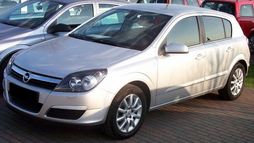
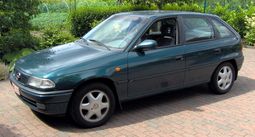
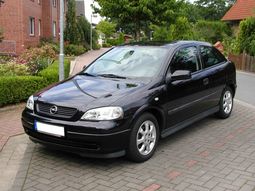
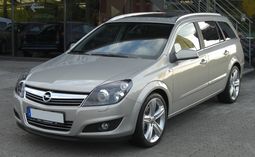
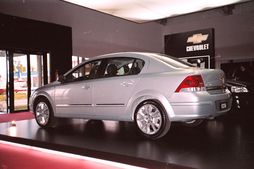
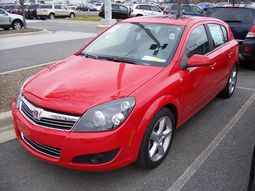
|